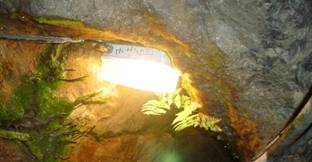To learn how low you can go, let us consider the illustrative example of the gentle Lampenflora.

Lampenflora (translated page from German Wikipedia)
Totality of all autotrophic plants, which are located in caves in the
field of fixed lighting fixtures
These are plants which are adapted to very low light such as occurs in show caves. They occur on the wet surfaces around lights. They are studied because they are a nuisance and damaging to the cave. How low can light be to sustain a population of Lampenflora?
CONTROL OF LAMPENFLORA AT WAITOMO CAVES. NEW ZEALAND
http://www.ackma.org/papers/Wait3.html
Light - The restricted occurrence of lampenflora to areas directly lit
by the fixed lamp housings in the caves clearly shows that light is
the primary controlling factor for lampenflora development. The
extent of lampenflora growth around any one lamp housing depends on
the number of bulbs in that housing and on the distance of that
housing from a suitable substrate. Light intensity measurements made
in the Glow-worm and Ruakuri caves suggest that the minimum light
levels required for continued growth of the different autotrophic
lampenflora organisms are: green and blue- green algae 0.1 to 1.0u E
/m2 /sec ( 10 to 50 lux) , mosses 1.0 to 3.5u E / m2/sec ( 50 to 180
lux), and ferns 5.0u E/m 2/sec ( 250 lux).
So that is how much the lampenflora need. Now how much does the moon provide?
https://en.wikipedia.org/wiki/Moonlight
The intensity of moonlight varies greatly depending on its phase, but
even the full Moon typically provides only about 0.05–0.1 lux
illumination.[2] When the full Moon is at perigee and viewed around
upper culmination from the tropics, the illuminance can reach up to
0.32 lux.[2]
A range of 0.05 to 0.32 lux. Our moon provides an order of magnitude less light than the lampenflora require. But the OP asserts that the glowy moon of this world provides 12,000 times the light of the moon, which means 600 to 3840 lux! Far more than the lampenflora require, even at the low end of the range, even the light hungry ferns!
So the answer is yes. Glowy moon as described is enough light for photosynthesis.

